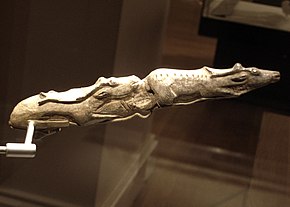Swimming Reindeer

The 13,000-year-old Swimming Reindeer sculpture
|
|
| Material | Mammoth ivory |
|---|---|
| Size | 207 mm long |
| Created | 13,000 years ago |
| Discovered | Bruniquel, France |
| Present location | British Museum, London |
| Registration | Palart.550 |
The Swimming Reindeer is the name given to a 13,000-year-old Magdalenian sculpture of two swimming reindeer conserved in the British Museum. The sculpture was made in France by an unknown artist who carved the artwork from the tip of a mammoth tusk. The sculpture was found in two pieces in 1866, but it was not until the early 20th century that Abbé Henri Breuil realised that the two pieces fit together to form a single sculpture of two reindeer swimming nose-to-tail.
The pieces of the sculpture were discovered by a French engineer, Peccadeau de l’Isle, in 1866 while he was trying to find evidence of early man on the banks of the River Aveyron, although contemporary accounts attributed the find to Victor Brun, a local antiquarian. At the time, de l'Isle was employed in the construction of a railway line from Montauban to Rodez, and while digging for artefacts in his spare time he found some prehistoric flint tools and several examples of late Ice Age prehistoric art near a hill called Montastruc. The finds took the name "Montastruc", although the nearest village was Bruniquel. The hill was estimated to be 98 feet (30 m) high, and the artefacts were found beneath an overhang that extended for about 46 feet (14 m) along the river and enclosed an area of 298 square yards (249 m²). De l'Isle had to dig through 7 metres (23 ft) of material to get to the level where the artefacts were found. At this time it was thought that there were two separate carvings of reindeer as it was not obvious that the two pieces fitted together.
De l'Isle wrote a paper on his discovery, and his finds were exhibited in 1867 at the Exposition Universelle in Paris. People were intrigued to see the sophistication of his finds and this sculpture in particular. The carvings were remarkable in that they illustrate reindeer, which no longer live in France. Dating was possible as the two reindeer were carved in the ivory of an extinct animal. This dated the find as ancient and required a re-evaluation of the life of humans in the late Ice Age. This find was particularly astounding, as at that time no cave paintings had been discovered, and it was to be some years before those that were found were accepted as genuine. In fact it was only the work of Henry Christy and Edouard Lartet that had recently persuaded informed opinion that mankind had lived during the ice age and coexisted with mammoths.
...
Wikipedia
